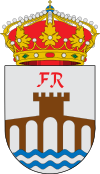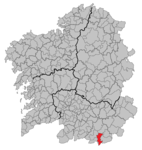Verín
| Verín municipality | ||
|---|---|---|
| coat of arms | Map of Spain | |

|
|
|
| Basic data | ||
| Autonomous Community : |
|
|
| Province : | Ourense | |
| Comarca : | Verín | |
| Coordinates | 41 ° 56 ′ N , 7 ° 26 ′ W | |
| Height : | 360 msnm | |
| Area : | 94.07 km² | |
| Residents : | 13,723 (Jan 1, 2019) | |
| Population density : | 145.88 inhabitants / km² | |
| Postal code : | 32600 | |
| Municipality number ( INE ): | 32085 | |
| administration | ||
| Mayor : | Juan Manuel Jiménez Morán PP | |
| Address of the municipal administration: | Praza Do Concello 1, 32600 VERÍN | |
| Website : | www.verin.net | |
| Location of the municipality | ||

|
||
Verín is a place and also the administrative center of the same name, consisting of 15 parishes ( Municipio ) in northwestern Spain. It is located in the province of Ourense ten kilometers north of the Portuguese border in the autonomous region (Comunidad Autónoma) Galicia on the river Tâmega . The place is known for its mineral springs Fontenova , Sousas and Cabreiroá .
geography
The 13,723 inhabitants (as of January 1, 2019) of the municipality of Verín live in the south-eastern quadrant of the province. The municipality borders the Portuguese border in the south and extends over an area of 93.9 km². The municipality cannot be avoided on the way from Galicia to Portugal and Castile. In addition, because of the quality of the medicinal springs in Fontenova, Cabreiroá, Sousas and Fonte do Sapo, it is a traditional spa town that is mainly visited in summer. The small town in the heart of the fertile area of the valley of Monterrei arose at the foot of an important medieval fortress and is an important city center of the province. The Verín Basin is characterized by the valley of the Támega River and mountain massifs in the west, with the Alto de Valdeauga being the highest point with a height of 940 meters.
The Creba da Corga geological break, in the area of which the medicinal water springs are located, is detectable in the municipality. The area is drained to the river Támega, into which the Abedes and the small rivers Novo and Gondulfes flow. The Abedes River is part of the Duero River basin .
Flora and fauna
On the mountain slopes there are mainly large forest areas with some very old trees, often pines. The fertile valley is characterized by viticulture, the grapes of which make the famous Monterrei wine. The climatic conditions, which favor the quality of the wine, are characterized by mild temperatures in winter, warm summers and low rainfall.
Parroquias
The municipality of Verin is divided into 15 parroquias (parishes)
- Ábedes 357 inhabitants 2008 41 ° 56 ′ 17 ″ N , 7 ° 24 ′ 35 ″ W
- Cabreiroá 159 inhabitants 2008 41 ° 55 ′ 2 ″ N , 7 ° 25 ′ 37 ″ W
- Feces de Abaixo 429 inhabitants 2008
- Feces de Cima> 108 inhabitants 2008
- Mandín 194 inhabitants 2008
- Mourazos 170 inhabitants 2008
- Pazos 678 inhabitants 2008
- Queirugás 125 inhabitants in 2008
- Queizás 423 inhabitants 2008
- A Rasela 351 inhabitants 2008
- Tamagos 188 inhabitants 2008
- Tamaguelos 224 inhabitants 2008
- Tintores 511 inhabitants 2008
- Verin 9979 inhabitants 2008
- Vilamaior do Val 341 inhabitants 2008
history
The oldest traces of settlement are finds of Neolithic ceramics in the village of Santa Ana. Dolmens and Mámoas are evidence of the continued settlement as well as the Stone Age sculptures around Abedes . The Celtic tribe of the Tamagani left their mark on the place names of many places. Milestones can be found as signposts and thus evidence of Roman presence in this area on the XVII. and XVIII. towards Antonino.
The first written mentions with the name Verin come from the 9th and 10th centuries. The city in the heart of the fertile valley of Monterrei arose at the foot of the important medieval fortress. The place was called "Head of the Baronceli Valley". Verin is also the place where Ordoño II and the father of Saint Rosendo met to agree to found the Ribas de Sil Monastery .
After the abolition of the lordship ( disamortization ) in the first third of the 19th century, two municipal districts were formed: Verín and Mandín, which both belonged to the administrative district of Monterrei and which merged in 1836 in what is now Verín.
The first printing press in Galicia was in Monterrei . The Misal Auriense, a copy of which is in Ourense Cathedral , was printed in Monterrey Castle in 1492 .
Way of St. James
Verin is a stop on the Way of St. James , the Camino Sanabrés , which continues along Via de la Plata towards Ourense from Zamora .
Population development of the municipality
Results of the municipal council elections
In the municipal council elections from 2007 onwards, the 17 seats were awarded as follows:
| Political party | Seats 2007 | Seats 2011 | Seats 2015 |
|---|---|---|---|
| PP | 9 | 10 | - |
| PSOE | 4th | 4th | - |
| ADEI-O | 1 | - | - |
| Bloque Nacionalista Galego | 2 | 3 | - |
| Verin | 1 | - | - |
economy
| Employees | Percentage | ||||
|---|---|---|---|---|---|
| TOTAL | 3,788 | 100 | |||
| Agriculture, livestock and fishing | 80 | 2.11 | |||
| Industry | 439 | 11.59 | |||
| Construction industry | 419 | 11.06 | |||
| Service companies | 2,850 | 75.24 | |||
| * Data from the Statistical Office for Economic Development in Galicia , IPI | |||||
Attractions
Visitors to the municipality of Verín reach the small town via the old bridge over the Támega River, which Philip II had built and which was renovated in 1759 by the Count of Monterrei. On the left side of the main street is the old quarter. Their squares and antique houses with coats of arms, such as the noble house Asistente, or the pazo (noble family house) de Acevedo, where King Felipe 'O Fermoso' (Felipe the Fair) stayed, the monastery of Mercedarios with a baroque tower and large balustrade or the church of Santa María from the XVI. Century form an interesting unit - not so much because of their architectural value, but because of their memorable value. Because of its artistic value, it is worth mentioning the figure of Cristo das Batallas (Christ of Battles), who is in the church mentioned. Other attractions are:
- Castillo de los Condes de Monterrey - one of the most monumental fortifications in Galicia from the 15th century .
- Iglesia de Santa María de Gracia - Romanesque church from the 13th century , which Alfonso X had built.
Celebrations and events
Verín celebrates the feast of Saint Lazarus, which is celebrated at the same time as the Monterrei Wine Festival . In addition, here we celebrate the feast Maios on 1 May, and on September 8, the festival ( Patron Saint ) of the community. On August 1st, the parish of Pazos honors Saint Fiz, on January 17th is the popular festival of Saint Anthony and the festival of paprika sausage in Abedes . On the 3rd, 11th and 23rd of each month the Verín market is held, where you can eat the traditional "pulpo" (octopus) in many places. Every year the Entroido (Carnival / Fastnacht) is celebrated in a big way. All dates can be found on the municipality's calendar of events.
Leisure time
In addition to the banks of the Támega, the municipality also has parks in Olivar, Alameda and Chaves, where the swimming pool is also located. To the north there is a hiking trail on the river bank towards Tintores, next to it a so-called fountain trail that starts at Fonte do Sapo and leads past Queirugas, the sanctuary of Remedios and the fountain and spa of Caldeliñas.
Feces de Abaixo is reached to the south. The spas can be reached from the town center, Fontenova is one, Sousas a little more than two kilometers away. Close to Sousas is Cabreiroá with the natural area Pozo do Demo and the mountain Monte Maior, which offers a good view over the valley and the city.
Individual references and sources
- ↑ Cifras oficiales de población resultantes de la revisión del Padrón municipal a 1 de enero . Population statistics from the Instituto Nacional de Estadística (population update).
- ↑ Postcode as specified on ingeniuz.com (Spanish)
- ↑ Address of the pilgrim hostel ( page no longer available , search in web archives ) Info: The link was automatically marked as defective. Please check the link according to the instructions and then remove this notice.
- ^ Spanish Ministry of the Interior
- ↑ Verín calendar of events on the municipality's website (Spanish)

